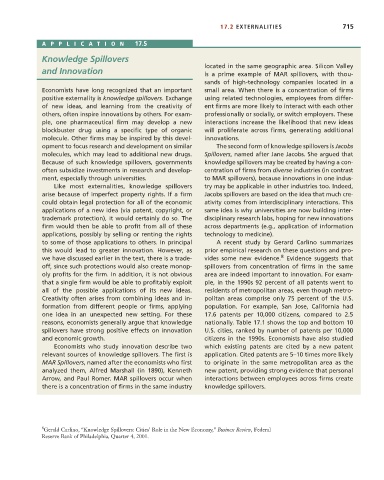Page 741 - Microeconomics, Fourth Edition
P. 741
c17ExternalitiesandPublicGoods.qxd 8/22/10 4:56 AM Page 715
17.2 EXTERNALITIES 715
APPLICA TION 17.5
Knowledge Spillovers
located in the same geographic area. Silicon Valley
and Innovation is a prime example of MAR spillovers, with thou-
sands of high-technology companies located in a
Economists have long recognized that an important small area. When there is a concentration of firms
positive externality is knowledge spillovers. Exchange using related technologies, employees from differ-
of new ideas, and learning from the creativity of ent firms are more likely to interact with each other
others, often inspire innovations by others. For exam- professionally or socially, or switch employers. These
ple, one pharmaceutical firm may develop a new interactions increase the likelihood that new ideas
blockbuster drug using a specific type of organic will proliferate across firms, generating additional
molecule. Other firms may be inspired by this devel- innovations.
opment to focus research and development on similar The second form of knowledge spillovers is Jacobs
molecules, which may lead to additional new drugs. Spillovers, named after Jane Jacobs. She argued that
Because of such knowledge spillovers, governments knowledge spillovers may be created by having a con-
often subsidize investments in research and develop- centration of firms from diverse industries (in contrast
ment, especially through universities. to MAR spillovers), because innovations in one indus-
Like most externalities, knowledge spillovers try may be applicable in other industries too. Indeed,
arise because of imperfect property rights. If a firm Jacobs spillovers are based on the idea that much cre-
could obtain legal protection for all of the economic ativity comes from interdisciplinary interactions. This
applications of a new idea (via patent, copyright, or same idea is why universities are now building inter-
trademark protection), it would certainly do so. The disciplinary research labs, hoping for new innovations
firm would then be able to profit from all of these across departments (e.g., application of information
applications, possibly by selling or renting the rights technology to medicine).
to some of those applications to others. In principal A recent study by Gerard Carlino summarizes
this would lead to greater innovation. However, as prior empirical research on these questions and pro-
8
we have discussed earlier in the text, there is a trade- vides some new evidence. Evidence suggests that
off, since such protections would also create monop- spillovers from concentration of firms in the same
oly profits for the firm. In addition, it is not obvious area are indeed important to innovation. For exam-
that a single firm would be able to profitably exploit ple, in the 1990s 92 percent of all patents went to
all of the possible applications of its new ideas. residents of metropolitan areas, even though metro-
Creativity often arises from combining ideas and in- politan areas comprise only 75 percent of the U.S.
formation from different people or firms, applying population. For example, San Jose, California had
one idea in an unexpected new setting. For these 17.6 patents per 10,000 citizens, compared to 2.5
reasons, economists generally argue that knowledge nationally. Table 17.1 shows the top and bottom 10
spillovers have strong positive effects on innovation U.S. cities, ranked by number of patents per 10,000
and economic growth. citizens in the 1990s. Economists have also studied
Economists who study innovation describe two which existing patents are cited by a new patent
relevant sources of knowledge spillovers. The first is application. Cited patents are 5–10 times more likely
MAR Spillovers, named after the economists who first to originate in the same metropolitan area as the
analyzed them, Alfred Marshall (in 1890), Kenneth new patent, providing strong evidence that personal
Arrow, and Paul Romer. MAR spillovers occur when interactions between employees across firms create
there is a concentration of firms in the same industry knowledge spillovers.
8 Gerald Carlino, “Knowledge Spillovers: Cities’ Role in the New Economy,” Business Review, Federal
Reserve Bank of Philadelphia, Quarter 4, 2001.

